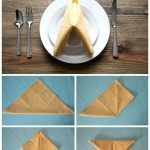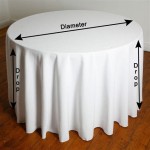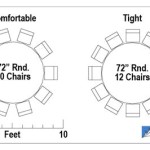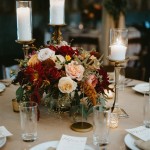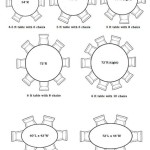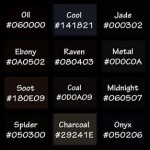Purpose of Table Napkin Folding Techniques
Table napkin folding, an art form that elevates the dining experience, extends beyond mere aesthetics. While visually appealing napkin designs contribute to the ambiance of a formal or casual setting, the practice serves several practical and functional purposes. Understanding these purposes allows for a more informed appreciation of the thought and effort involved in this often-overlooked detail of table setting.
The primary function of a table napkin, regardless of its folded presentation, is to maintain cleanliness during a meal. A napkin provides a readily available means to wipe spills, clean fingers, and protect clothing from accidental food stains. The act of folding a napkin does not diminish its core purpose; rather, it enhances its accessibility and presentation.
Hygiene and Convenience
A neatly folded napkin offers hygienic advantages. Folding helps to keep the surface intended for use clean and untouched, as it minimizes exposure to potential contaminants before the diner requires it. The act of unfolding the napkin, therefore, presents a clean and protected surface for use.
Moreover, certain folding techniques contribute to convenience. Some folds create pockets or layers that can be used to hold cutlery, reducing the need for extra table space and providing a tidy arrangement. Other folds create a raised profile, making the napkin easier to grasp and unfold, especially for individuals with limited dexterity.
The presentation of the napkin also influences the diner's perception of hygiene. A carefully folded napkin implies attention to detail and cleanliness, subconsciously reassuring the guest of the overall hygiene standards of the establishment or host.
Enhancing Aesthetics and Ambiance
Beyond its functional role, table napkin folding significantly contributes to the aesthetic appeal of a table setting. Creative and intricate folds transform a simple piece of cloth into an element of visual interest, complementing the overall design and theme of the dining experience.
The choice of napkin fold can reflect the formality of the occasion. A simple pyramid or fan fold might be appropriate for a casual luncheon, while more elaborate designs, such as the artichoke or lotus fold, suggest a more formal and sophisticated setting. The color and texture of the napkin, combined with the specific fold, can further enhance the aesthetic impact, aligning with the overall color scheme and décor of the event.
Furthermore, napkin folding can serve as a personal touch, demonstrating the host's care and attention to detail. It communicates a sense of hospitality and effort, making guests feel valued and welcome. The creativity and skill involved in more complex folds can be impressive, adding a sense of artistry to the dining experience.
The visual impact of a well-folded napkin contributes significantly to the overall ambiance. It elevates the table setting beyond mere functionality, transforming it into a visually pleasing and inviting space. This attention to detail creates a more enjoyable and memorable dining experience for all involved.
Communication and Subtle Messaging
In addition to hygiene, convenience, and aesthetics, napkin folding can also serve as a form of subtle communication. The chosen fold, the placement of the napkin, and the addition of decorative elements can all convey specific messages or intentions.
For instance, a napkin placed directly on a plate might indicate a more informal setting, while a napkin placed to the left of the forks is a more traditional and formal arrangement. Certain folds might be chosen to complement a specific theme or occasion. A Christmas tree fold, for example, is clearly indicative of a holiday celebration. Similarly, a heart-shaped fold might be appropriate for a romantic dinner.
The use of napkin rings can also communicate a message. Personalized napkin rings, bearing the names or initials of guests, add a personal touch and serve as a thoughtful gesture. The material and design of the napkin ring can also contribute to the overall aesthetic and theme of the event.
Moreover, the act of unfolding a napkin can have symbolic significance. In some cultures, the deliberate unfolding of a napkin signals the start of the meal. This subtle gesture creates a sense of anticipation and marks the beginning of the dining experience.
The careful consideration given to napkin folding demonstrates a level of attentiveness that extends beyond mere practicality. It subtly communicates a message of care, hospitality, and attention to detail, contributing to a more meaningful and memorable dining experience. While seemingly a small detail, the effort invested in napkin folding reflects a dedication to creating a positive and welcoming atmosphere for guests.
The choice of napkin fabric, whether linen, cotton, or a disposable material, also affects the ease and effectiveness of different folding techniques. Linen, known for its crispness, holds folds well and creates sharp, defined shapes. Cotton is a more versatile option, suitable for a wider range of folds. Disposable napkins, while convenient, may be more limited in the types of folds they can support due to their texture and flexibility.
Furthermore, the size of the napkin influences the suitability of certain folds. Larger napkins are generally required for more intricate and elaborate designs, while smaller napkins are better suited for simpler folds. The proportion of the folded napkin to the plate and other table elements is also an important consideration in creating a balanced and aesthetically pleasing table setting.
The practice of table napkin folding, therefore, encompasses a range of considerations, from functional hygiene to aesthetic enhancement and subtle communication. Understanding these purposes allows for a more informed and appreciative approach to this seemingly simple, yet surprisingly impactful, element of the dining experience. The selection of the appropriate fold, material, and placement requires careful thought and attention to detail, ultimately contributing to a more enjoyable and memorable occasion for all involved.

How To Fold Table Napkins Classic Techniques And Ideas
:max_bytes(150000):strip_icc()/a98917_1101_lotus_xl-7c62cdf1e36c44ef958623e16d48d274.jpg?strip=all)
How To Fold Napkins In 13 Ways

28 Creative Napkin Folding Techniques

Pendant Fold Napkin Technique Like An Expert Bumblebee Linens

Learn The Fine Art Of Napkin Folding Foodal

24 Napkin Folding Ideas How To Fold A Diffe Ways

Learn The Fine Art Of Napkin Folding Foodal

The 4 Napkin Folding Techniques Every Restaurant Needs To Know Alliance Blog

27 Napkin Fold Ideas

How To Fold A Napkin For Table Setting
Related Posts


